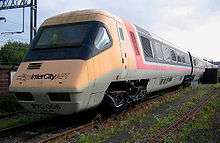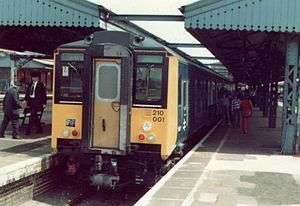British Rail Engineering Limited
British Rail Engineering Limited (BREL), incorporated on 31 October 1969, was the railway systems engineering subsidiary of British Rail until the design and building of trains in the UK was privatised in 1989.[1] BREL was purchased by the Swiss-Swedish conglomerate ABB Asea Brown Boveri (40%), Trafalgar House (40%) and a management-employee buy-out (20%). It has since become part of Bombardier Transportation.
 | |
| Industry | Train and carriage building |
|---|---|
| Fate | Privatised |
| Predecessor | British Rail Workshops |
| Successor | ABB |
| Founded | 31 October 1969 |
| Defunct | 1992 |
| Headquarters | London, United Kingdom |
| Parent | British Railways Board (1969-1989) |

Products
Diesels
Multiple units
- British Rail Class 140
- British Rail Class 141
- British Rail Class 142
- British Rail Class 144
- British Rail Class 150
- British Rail Class 154
- British Rail Class 158
- British Rail Class 159
- British Rail Class 165
- British Rail Class 166
- British Rail Class 210
- British Rail Class 252
- British Rail Classes 253 and 254
- British Rail Class 312
- British Rail Class 313
- British Rail Class 314
- British Rail Class 315
- British Rail Class 317
- British Rail Class 318
- British Rail Class 319
- British Rail Class 320
- British Rail Class 321
- British Rail Class 322
- British Rail Class 370
- British Rail Class 442
- British Rail Classes 445 and 446
- British Rail Class 455
- British Rail Class 456
- British Rail Class 457
- British Rail Class 465
- British Rail Class 488
- British Rail Class 507
- British Rail Class 508
- British Rail Class 510
- NIR Class 80
- NIR Class 450
- Taiwan Railway EMU100 series
BREL also produced some railbuses.
Coaches
Main products

The vast majority of BREL's output was rolling stock for British Rail, including Mark 2 and Mark 3 carriages, the latter for locomotive haulage and InterCity 125 diesel High Speed Trains. BREL built the NIR 80 Class diesel-electric multiple units for Northern Ireland Railways. Other Mark 3 derived vehicles included Class 150 diesel multiple units in the 1980s and numerous electric multiple units such as Classes 313 and 317.
BREL had limited success in the export market, notably with Mark 2 and Mark 3 carriages for Irish Rail and the Taiwan Railway EMU100 series.
Other products


BREL built prototypes such as the Class 210 DEMU and the experimental high-speed Advanced Passenger Train (APT) tilting train during the 1970s and early 1980s.[2] The Class 210 were externally very similar to the first batch of Class 317 EMUs, but half of the forward carriage was taken up by the engine room, where an above-floor diesel engine drove a generator to power traction motors on the axles.
Locations
BREL's major production centres were at Crewe (Crewe Works), Derby (Derby Litchurch Lane Works and Derby Works), Doncaster (Doncaster Works), Glasgow (Glasgow (St Rollox) Works), Shildon (Shildon Works) and York (BREL York). The historic site at Wolverton in Milton Keynes was progressively run down until the 1980s before being relegated to maintenance duties.
Not all British Rail rolling stock was built in-house: Metro Cammell, Brush Traction and Metropolitan-Vickers amongst others manufactured rolling stock, although in general it was built to BREL specifications. Latterly, BREL often acted as a subcontractor to a main contractor such as GEC, which supplied traction equipment. These contracts required BREL to build the frames, body shells and bogies, and install the traction and ancillary equipment of the primary contractor. Much of the electric locomotive construction programme of the 1980s, such as Classes 87, 90 and 91, was carried out in this way.
Privatisation
In 1989 BREL was purchased by the Swiss-Swedish conglomerate ABB Asea Brown Boveri (40%), Trafalgar House (40%) and a management-employee buy-out (20%). In 1992 it was bought out by ABB to form ABB Transportation Ltd.[3] It has since become part of Bombardier Transportation.
In 1996, BREL York closed.
In 2005 the Metro-Cammell plant in Washwood Heath, Birmingham closed which meant that for ten years from 2005 to 2015 Bombardier's former BREL site, the Derby Litchurch Lane Works, was the sole plant in the UK actively manufacturing stock. This unique role was ended by Hitachi and John Laing in 2015 when they opened the new Agility Trains factory in County Durham. CAF also built CAF Newport, a £30 million factory at Llanwern near Newport.[4]
See also
References
- "British Rail Workshops". www.railwaybritain.co.uk. Archived from the original on 12 April 2010. Retrieved 2 August 2010.
- "This is British Rail (reproduction of the text of a British Rail leaflet)". www.apt-p.com.
- Industrial Railway Society Bulletin No 544, January 1993
- "More than 3000 new Welsh jobs created following inward investment". GOV.WALES. Retrieved 9 August 2019.
External links
| Wikimedia Commons has media related to British Rail Engineering Limited. |